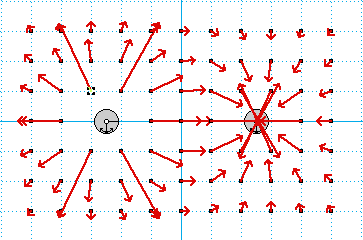 |
|
Solution: One of the problems with both the IP and Excel simulations was that the positive test particles would immediately fly off of the screen once the simulation started. Looking at the formula, this makes sense.
When r is very small, the resulting electrostatic force from that charge is tremendous, rendering the force from the other charge negligible. We circumvented this issue by placing the test charges on an evenly spaced grid with interactive physics. By turning on the trace feature, we can see the movement of these charges over time. We noticed one important error with this method. Depending on the mass of the test particles, field lines were distorted to various degrees.
Contrary to popular belief, field lines do not show the movement of a small test particle, but instead show the instantaneous direction of the net force on the test particle. In actuality, the particle will move in a path outside of the real field lines. Think momentum. Once the particle gets going, the net force will only try to change the direction, but the more momentum it builds up, the harder it is to change that direction.
Possible solution: Make a tight grid of test charges with large masses. The vectors show net force: not quite field lines, but they do show the field. Here is what I came up with. The snapshot above can be recreated by downloading the "Vectors.IP" file below.
|



